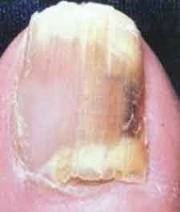Posts Tagged ‘prescription medications’
Available Prescription Medication for Fungal Toenail Infections
Available Prescription Medication
for Fungal Toenail Infections
 Antifungal medications are most commonly used to treat toenail fungus infections. These are normally oral prescription medications and unfortunately have a long list of potential risks and side effects. There are topical fungicides that are prescription strength and available on advice of your doctor. Both kinds of medication require a treatment regimen of 12 weeks for toenail fungus and 6 weeks for fingernail fungus. The length of treatment can vary with the severity of the infection.
Antifungal medications are most commonly used to treat toenail fungus infections. These are normally oral prescription medications and unfortunately have a long list of potential risks and side effects. There are topical fungicides that are prescription strength and available on advice of your doctor. Both kinds of medication require a treatment regimen of 12 weeks for toenail fungus and 6 weeks for fingernail fungus. The length of treatment can vary with the severity of the infection.
Curing a toenail fungus infection can be very difficult and time consuming. Before you and your doctor agree on a treatment, it must be determined what kind of fungal infection you are suffering from. Once this is established, your doctor will prescribe a medication to eliminate the fungus. This is where you need to be educated and verbose. You need to tell your doctor about all of the medications you are taking, including supplements and herbal remedies. The prescriptions available to cure fungal nail infections are very hard on the system and can cause serious drug interactions.
Lamisil (otherwise known as terbinafine) is the most popular medication used to treat fungal infections. This medicine is most effective for dermatophytic infection. Lamisil is prescribed at 250 mg per day for 6-12 weeks. Another component of this medication is numerous blood tests to ensure that your liver is healthy enough to follow this regimen and that no damage is occurring during the treatment cycle. This makes this particular treatment very expensive. An initial baseline test will be done to determine your liver health before you start treatment. During treatment, your doctor will require that you visit the office and may order blood tests throughout the treatment at random, or regular intervals. This is done because Lamisil is processed by the liver and there is the potential for several rare hepatic side effects, including hepatitis, blood dyscrasias and Stevens-Johnson syndrome. Following your doctor’s recommendations can protect you from serious liver damage over the course of your treatment.
Another well known antifungal used to treat toenail infections is Diflucan (or fluconazole) Diflucan is most commonly used to treat yeast infections.
Both of these medications can be found in their generic form at pharmacies all over the country for about $4.00 Numerous pharmacies, including Target, Wal-Mart and Publix offer prescription drugs at a discounted rate. Please note, you must have a doctor’s prescription to acquire these medications. If you need to take these drugs for an extended period, it may be worth the effort to research which pharmacies offer this program.
Other medications commonly used to treat toenail fungus infections are:
- Ciclopirox (commercial name – Penlac) a topical nail lacquer used to infuse the nail with medication
- Itraconazole (commercial name – Sporanox) is a newer medication and works similarly to Lamisil
- Griseofulvin is an older drug and is no longer regularly prescribed due to its lack of efficacy
- Ketoconazole (commercial name – Nizoral) although very effective at eliminating fungus, is not prescribed often because of the high risk of hepatotoxicity.
You and your doctor can work together to find the best antifungal treatment to cure your toenail fungus. The most important part of your treatment will be discouraging the growth of fungus on your own by making sure that your feet are clean, dry and surrounded by breathable materials so that you are not offering a hospitable environment. By following this simple advice, you are much more likely to find yourself fungus free at the end of your treatment.
Some Useful Information When Looking for Nail Fungus Treatments
Some Useful Information When Looking
for Nail Fungus Treatments
 Nail fungus, known medically as Onychomycosis, is not an easy condition to treat. Primarily cosmetic in nature, it most commonly affects the toenails.
Nail fungus, known medically as Onychomycosis, is not an easy condition to treat. Primarily cosmetic in nature, it most commonly affects the toenails.
People who are at risk for contracting nail fungus are:
- Older people,
- Males,
- People with diabetes
- People who have had trauma to their nails
- People with hyperhydrosis
- People who suffer from peripheral vascular disease
- People who have athlete’s foot
- People with an immunodeficiency
- People who practice poor hygine
- People who spend a lot of time in the water
There are a number of different species of fungus that can infect the nail. It is also common to find several different fungal infections at one time. The visible symptoms of nail fungus are a thick, discolored and distorted looking nail.
Curing nail fungus has historically been problematic. Modern medicine has found several new options for curing nail fungus. Visiting your health care provider to determine what kind of infection you have and confirming that it is in fact a nail fungus, instead of some other nail infection, is paramount to a successful treatment regimen. Discovery of this is fairly simple. Your doctor can take scrapings and/or clippings of the infected nail to examine under a microscope, and if necessary, send to a lab for culture.
Once you know what you are dealing with, your nail fungus treatment can begin. A common treatment option is an oral prescription antifungal medication. Two older, and therefore proven and well documented, medications are griseofulvin and fluconazole. Unfortunately these medications aren’t effective on all forms of nail fungus and for the fluconazole, the treatment can last up to 9 months.
Two new comparatively to the market prescription medications that have proven effective against nail fungus are terbinafine and itaconazole. These have both proven to be more effective than their older cousins, fluconazole and griseofulvin.
Terbinafine is taken daily over the course of three months. It is reported to be well tolerated with no negative drug interactions with other medications or significant side effects.
Itaconazole runs in a weekly cycle of three weeks on and three weeks off over the course of 3-5 months. People who take a protease inhibitor should not take itaconazole.
For those who do not wish to take an oral prescription, there are alternatives.
A topical medication is now available for curing nail fungus. Your doctor can prescribe using a nail polish containing 8% ciclopirox solution. You paint this on your nail, as you would a regular nail polish, and the adjacent skin every day for 12 months. This treatment is not as effective as oral prescription medication and the course of treatment is lengthy.
As you consider how to treat your onychomycosis, please keep in mind that no matter what medication you choose and however long the treatment cycle is, the nail has to grow out completely clear before the fungus is considered gone. It can take some people more than a year to replace a disfigured toenail.
There are some folks who opt for surgery. This is a more drastic treatment for nail fungus and should be considered a later option as it can be both painful and possibly disfiguring. If other options are unavailable to you because other medications are either ineffective or inappropriate, this can be a good solution to your nail fungus problem.
Alternative medicine treatments are another possible solution. Tea Tree Oil has been shown in some studies to cure nail fungus. The Mayo Clinic has one published report if you are interested in reading up on this treatment.
There are many home remedies that have been suggested by individuals who have had success with them. Most of these are not considered to be viable treatments by the medical community, but that does not mean they cannot prove effective. Home remedies include:
- A 20-30 minute foot soak in vinegar, lemon juice, Listerine, or a solution of bleach
- Nutritional supplements such as acidophilus
- Applying baking soda, garlic, olive oil or Vick’s VapoRub to the infected nail
Modern medicine has created many successful options when it comes to curing nail fungus. Consulting your health care provider and doing some research yourself are two positive steps in the right direction. Armed with the correct information, you and your health care provider can create an effective plan to solve your nail fungus problem.